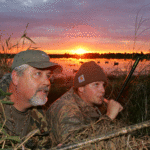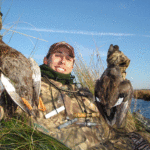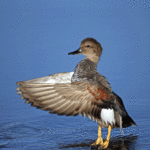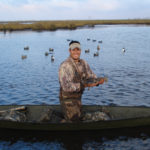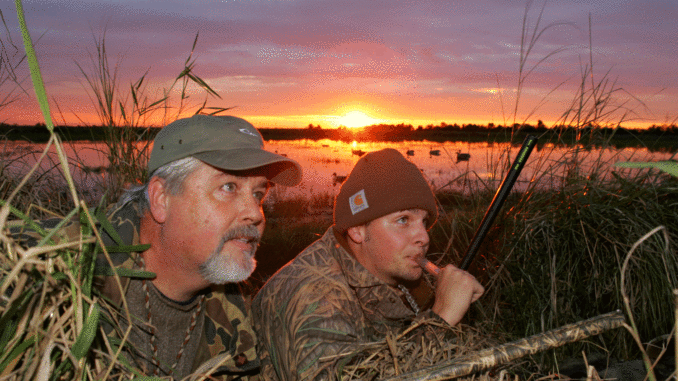
Use these techniques to fill your bags this duck season.
It was the perfect lease. After years of waiting, they had finally landed a prime duck-hunting lease, and opening day had arrived. As they waited in the pre-dawn darkness, they rehearsed their shots at the imaginary gray ducks and widgeon that would surely be swinging into the decoys when legal shooting time arrived — a mere 15 minutes away.
Legal shooting time finally came with scores of ducks filling the sky and the frantic barrage of gunfire that explodes in the marsh each opening day.
“Teal at one o’clock! Grays off to the left,” the excited hunters barked out.
Ducks were everywhere but nothing was decoying and the birds were ignoring their setup. How could this be?
In early summer, these two duck hunters had toured their new lease and thought they had found the perfect pond. It was a figure-eight-shaped pond with a spot for the blind on the peninsula in the middle of the eight. Surely every duck would have to fly past this spot, and they would see the decoys and drop in. They even named the spot “The Graveyard” before they had even made a single hunt.
This setup would be perfect, they could hunt any wind direction, the pond was deep enough to defy the howling northwest wind that would drain the surrounding marsh and they would build a blind that was so comfortable it would become known as “The Condo.” They headed home that day bragging about what they had found and looking for new recipes for the innumerable ducks they were sure they would bag once the season started.
Two weeks before the season, the two hunters were back on their lease. On the way in, they saw quite a few ducks rising from the broken marsh and small ponds that surrounded the “perfect pond.” They dismissed this observation and the fact that no ducks were around their blind with a litany of excuses that marsh hunters routinely recite — “Those ponds will be dry on a north wind, and once the shooting starts, the ducks will be everywhere. All we have to do is put out a few decoys, and they will be all over us. Those ponds are too hard to get to, only mottled ducks use the broken marsh.”
With that, they began the construction of The Condo. It was the ultimate duck blind, complete with a large platform, thick roseau cane so it could withstand the whole season of hard winds, a built-in bench, dog platform and pirogue house. It was large enough to bring half of the neighborhood so they could show off their great duck hunting spot.
With their work over, they admired their creation, and on the way out they again saw ducks in the same broken marsh area that was within a few hundred yards of The Condo. They raised their paddles in the air and pretended to shoot at the ducks shouting “We will get you on opening day!”
On opening day, at 9 a.m., these two duck hunters were shaking their heads in disbelief as they stared at three teal, one spoonbill and two ringnecks that had flown too low and too close to The Condo. All were taken by pass shooting. The ducks were in the area in good numbers, but this pair of hunters had made all the classic marsh-hunting mistakes.
Duck hunting in the marsh in South Louisiana is very different from hunting ducks in other habitats and different areas of the state and country. If you want to be a successful marsh duck hunter, you have to throw out many of the myths associated with “classical duck hunting” and take the advice of experienced marsh hunters who have been successful by rewriting the rules.
I caught up with Capt. Howard Callahan, who was willing to share some of his techniques for the marsh. Callahan has been chasing ducks in Southeast Louisiana for more than 40 years, mostly in the Caernarvon and Bayou Bienvenue areas. He hunts about 50 days of the 60-day season, and has learned though experience how to hunt ducks in the marsh.
Hunt where the ducks are
Callahan’s first and most critical element of success is to hunt where the ducks are.
“It sounds so simple and elementary, yet so many duck hunters ignore this simple rule and hunt in unproductive areas over and over again when they see ducks using an area that is close by,” Callahan said. “On every lease, and even on every pond, there are areas that attract ducks better than other areas, and sometimes we never can figure out why. The only way to locate these areas is to observe ducks using them.”
Callahan explained how he finds where the ducks are.
“I am constantly scouting during the season,” he said. “I use binoculars while I’m hunting, and watch every flock to see where they’re headed and what flyways they’re using.
“After each hunt, I also go looking for where ducks are resting. You don’t want to chase the ducks out of the area, so when you see them get up, head the other way, but make a mental note of where they were resting. If you start processing all of the information you gather, you can put together a pretty good picture of where the ducks will be under different conditions and move to the areas the ducks are using. Your success will increase tremendously.”
In my experience, if I am hunting a new lease or property, I initially set up in an area that looks the most attractive to ducks, or better yet, in an area that I have flushed ducks. I don’t build an elaborate blind for the first season. I simply get in the grass and hide and observe where the ducks are flying and landing. I also use a pair of binoculars to pinpoint the activity of the ducks, and I take careful note of the wind direction and speed and tidal and other weather conditions. Ducks can act entirely different on different wind directions and speeds.
Before long, I have established a pattern of duck activity on my lease, and have a pretty good idea where the ducks will be, given a certain set of conditions.
After I have patterned the ducks, I can then begin to move with the ducks and place strategically located blinds in the hotspots. Hunters should have several locations available to be used as the conditions change. If you only have one pond to hunt, your options are limited, but you can still have several blind locations for different winds and conditions.
Natural and low-profile blinds
Once you have located where the ducks want to be, the second most important element is properly blinding yourself to the ducks. Callahan is a fanatic for natural-looking, low-profile blinds. He cuts willows, mung bushes and wax myrtles almost daily, and brings them in each morning.
“You can’t have too much natural-looking fresh cover,” said Callahan. “In the area that I hunt, many times I will just pull the pirogue on an island and stick bushes up around it.
“If you’re still when the ducks are working, that’s all you need.”
Callahan also uses one- and two-man pit blinds in locations that he knows will hold ducks year after year.
“The pits are awesome; the ducks never have a clue that you’re there,” he said. “When you stand to shoot, the ducks are literally in your face.”
I have found that one of the biggest mistakes hunters make is building blinds that don’t fit-in with the area they’re hunting. For years, hunters in our area have constructed platform blinds with wire and roseau cane. These blinds normally have a high profile and vegetation not found in the immediate area. Also, most hunters don’t redress their blinds during the season. As the surrounding marsh dies down with the cold weather, the blinds really stick out, and late-season ducks all seem to flair out of shooting range.
Remember, you have to be where the ducks are, so if you find a new location, simply bring in some natural cover on the morning of the hunt and make a makeshift blind. In most cases, you will be more successful than hunting one of your permanent blinds, especially late in the season
Use large decoy spreads
Decoys are the icing on the cake when you’re in a good area and have a natural and well-concealed blind. In the marsh, more decoys mean more ducks, and this is especially true in Southeast Louisiana where the marshland is vast and there are a lot of duck hunters trying to get ducks to land in their ponds.
Callahan recommends using as many decoys as you can. He uses at least five dozen.
“If coots are in area, use some coot decoys in your spread,” he said. “I like decoys with some white on them like scaup, pintails and divers.
“Spread them out in family groups, leaving an opening in front of the blind. I use weighted-keel decoys only. Spinning-wing decoys work best for teal and divers. The green-winged teal spinning wing decoy is my personal favorite because it lasts longer on batteries and spins fast.”
I use mostly teal and gray duck decoys because that makes up the majority of my bags. Late in the season, I will use some scaup decoys and place them in a separate group. I try to add realism to my spread by including both feeding decoys and sleepers. I also use different brands of decoys so that the spread doesn’t look like a bunch of clones sitting on the water. Like Callahan, I also use the green-wing teal spinning decoy, but if ducks start flaring, I’ll remove it from my spread.
Hunt before the fronts
My experience has been that ducks always seem to fly better on southeast winds before fronts. In my opinion, a wind of about 15-20 m.p.h and low rolling clouds are the best conditions to hunt. The low-pressure system sparks an activity cycle that really puts the birds on the move and makes them very easy to decoy. These are the hunts that you will talk about for years to come — the days when the ducks just kept coming in.
During a frontal passage (four hours on either side of the front) is also a great time to hunt because the wind change will often make the ducks move to a more secluded area. These are the times when you want to find a secluded cove or small pond where the ducks go to take shelter when the strong northwest winds begin to blow. It seems that the ducks really hold tight under these conditions and only fly when flushed off the water.
After the winds subside, the curse of the bluebird sky sets in with clear, cold and calm weather and the dreaded low tides. During these conditions, the ducks begin to move again, especially during the first hour of daylight, but hunting is very difficult because there is little wind to move the decoys and the clear conditions make it very easy for the ducks to pick out hunters and flare before coming into your setup. During these conditions, I’ll set up in open water on large deep lagoons with lots of decoys.
Hunt late
You’ve seen it at least a hundred times: No sooner have you unloaded your gun and begun picking up the decoys, then the ducks start filling the sky looking for a place to land. It’s been my experience that some of the most productive duck hunting — especially for quality ducks such as grays, widgeon, mallards and pintails — occurs between 9 and 11 a.m., especially late in the season.
Go easy on the calling
Calling ducks is almost an afterthought after you’ve covered the basics. I know many great duck hunters who simply can’t call ducks. Their secret is that they know they can’t, so they don’t try. When calling ducks, I use a low-key approach.
There are only two reasons to call ducks. The first is to get their attention so that they begin to move in your direction, and the second is to keep their attention so that they will make a landing approach, or at least fly within range. If ducks are working without calling — don’t call.
If you spot a flock of ducks in the distance that don’t appear to see your setup, you should give them one or two loud five-quack sequences, and then look for their response. If you have turned them, let them come by for a look and be alert to make sure they stay interested. If you begin to lose them, hit them with either a single quack or a quick three-note call until they make the first pass.
Sometime after the first pass, they will get a little suspicious of the setup. You will then have to use a pleading call to get them turned back. This call has an extended first note followed by three notes of a shorter duration. This call should turn them back and cup them up.
No calling is necessary when the birds are cupped and coming into the decoys. If they show signs of landing short or slipping off to the side, use a signal note quack or a feeding chuckle. Again, less is better.
If you are not a talented duck caller, you can use whistles, drake calls and other specialty calls if you want to add some audio to your setup. Of all of the elements of duck hunting, calling is the least critical.
